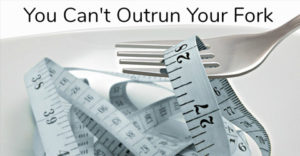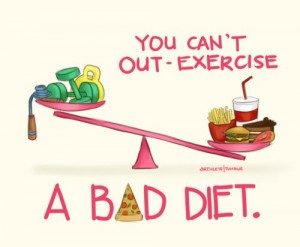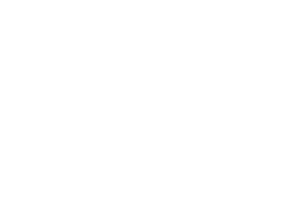
You have probably heard Michelle Obama and many others telling overweight people that they can drop their extra pounds by picking up their running shoes. But is this really the answer to the increasing epidemic of obesity spreading around the world?
An Instructor from T Colin Campbell’s Centre for Nutrition Studies considers that her personal experience suggests that this is simply NOT the answer…
Blog Contents
Healthy Weight Loss = 80% Nutrition + 20% Exercise
Eventually, she came across the landmark documentary film Forks Over Knives. Things changed from then on. And she was not alone. This very film revolutionised my life and the lives of many people I come across daily.
Terri, like many, many others, learned that optimal health was not about exercising more. Rather, it was about eating the right foods. “Not chicken and fish like I had thought, but whole grains, legumes, vegetables, and fruits!”
- Leanest cut of beef ~28% calories from fat
- Skinless chicken breast ~ 24% from fat
- Tuna ~21% from fat
- Salmon ~ 40% from fat
- Eggs ~70% from fat!
Nutrition is Key
Even though she continued to consider that exercise and stress management are important “…the real key—80% of the equation—is nutrition – in particular, eating plants.”
Now, her main exercise is walking the dog daily for around 30-45 minutes with some gentle yoga four days a week – without the dog, I guess!
She says that her cholesterol levels have dropped and she no longer suffers from inflammation or pain.
While exercise and stress management are “…very important pieces to the health puzzle; it’s not whole without them. But, nutrition is the biggest piece of the picture. “You can’t outrun your fork.” “
Some edited thoughts (1.) from Dr. Greger
The food industries like to blame inactivity as the prime cause of obesity, not the promotion and consumption of their calorie-rich products. (2.) On the contrary, however, research suggests that the level of physical activity may have actually increased in the United States over the past few decades. (3.) We know that obesity is rising even in areas where people are exercising more. (4.) This is likely explained by the fact that eating activity levels are outstripping physical activity levels. (5.)…Researchers who accept grants from the Coca-Cola Company (6.) call physical inactivity “the biggest public health problem of the 21st century.” (7.) Actually, physical inactivity ranks down at number five in terms of risk factors for death in the United States and number six in terms of risk factors for disability. (8.) And inactivity barely makes the top ten globally. (9.)
…diet is by far our greatest killer, followed by smoking. (10.)
Of course, that doesn’t mean you should sit on the couch all day…. in addition to helping you enjoy a healthy body weight, exercise can also ward off and possibly reverse mild cognitive decline, boost your immune system, prevent and treat high blood pressure, and improve your mood and quality of sleep, among many other benefits.
References
- Greger, Michael; Stone, Gene. How Not To Die: Discover the foods scientifically proven to prevent and reverse disease (Air Side Edt) (p. 393). Pan Macmillan. Kindle Edition
- Freedhoff Y, Hébert PC. Partnerships between health organizations and the food industry risk derailing public health nutrition. CMAJ. 2011;183( 3): 291– 2.
- Westerterp KR, Speakman JR. Physical activity energy expenditure has not declined since the 1980s and matches energy expenditures of wild mammals. Int J Obes (Lond). 2008;32( 8): 1256– 63.
- Dwyer-Lindgren L, Freedman G, Engell RE, et al. Prevalence of physical activity and obesity in US counties, 2001– 2011: a road map for action. Popul Health Metr. 2013;11: 7.
- Laskowski ER. The role of exercise in the treatment of obesity. PMR. 2012;4( 11): 840– 4.
- Archer E, Hand GA, Blair SN. Correction: Validity of U.S. Nutritional Surveillance: National Health and Nutrition Examination Survey Caloric Energy Intake Data, 1971– 2010. http:// journals.plos.org/ plosone/ article? id = 10.1371/ annotation/ c313df3a-52bd-4cbe-af14-6676480d1a43. October 11, 2013. Accessed April 23, 2015.
- Blair SN. Physical inactivity: the biggest public health problem of the 21st century. Br J Sports Med. 2009;43( 1): 1– 2.
- Murray CJ, Atkinson C, Bhalla K, et al. The state of US health, 1990– 2010: burden of diseases, injuries, and risk factors. JAMA. 2013;310( 6): 591– 608.
- Lim SS, Vos T, Flaxman AD, et al. A comparative risk assessment of burden of disease and injury attributable to 67 risk factors and risk factor clusters in 21 regions, 1990– 2010: a systematic analysis for the Global Burden of Disease Study 2010. Lancet. 2012;380( 9859): 2224– 60.
- Murray CJ, Atkinson C, Bhalla K, et al. The state of US health, 1990– 2010: burden of diseases, injuries, and risk factors. JAMA. 2013;310( 6): 591– 608.
Joe’s Final Comment

For many years I also considered that exercise was the main answer. I would train for marathons, work myself into the ground – pushing my body so hard that I repeatedly wrecked my muscles and joints; but still I would find that my unwanted weight crept back, and those damned “love handles” would never disappear.
Now, at the age of 56, my body feels like it is at its optimal weight – the lowest level since I was in my teens. I never go hungry or actively control the quantity of food I eat – and I eat A LOT!
Before “going cold turkey” into a WFPB diet, I was starting to feel old and pretty pessimistic about my future, even though I was very conscious of my dietary intake and had been a vegetarian on and off for most of my life.
Now, my arthritis has all but disappeared. My joints no longer ache. I no longer get constipated or have the recurrent mouth ulcers and nose bleeds that I had for years. Getting in and out of the car, or up from sofas, no longer causes exclamations of pain. I feel like I have more energy now than I had years ago. My mental attitude is consistently positive and…I am really looking forward to the future.
Of course my and Terri’s claims about the health benefits of a WFPB diet are merely anecdotal; but without a personal experience of the power of plant-eating I would not be able to recommend it to other people. I just wish my parents had been able to enjoy its health benefits instead of the lingering and painful diet-related diseases that they endured.
If you have a personal story that you think would inspire others, let me know.
